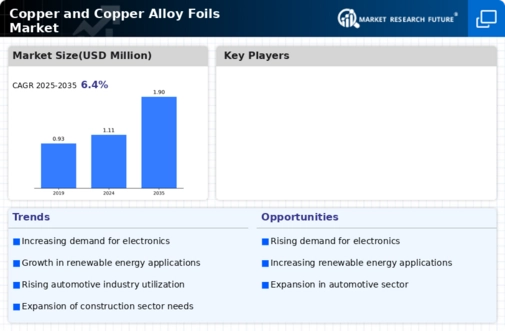Market Analysis
In-depth Analysis of Copper Alloy Foils Industry Industry Landscape
Copper stands as a pivotal metal in the marine industry, playing a crucial role in enhancing the strength and durability of various components and hardware. Notably, bronze, composed of 86–88% copper, emerges as a highly recommended copper alloy for manufacturing marine hardware. Its versatility and resistance to biofouling, particularly macrofouling, position bronze as an ideal choice. Several copper-bronze alloy groups are employed to produce marine hardware, including Cu-Sn-P (phosphor bronze), Cu-Sn-Zn (gunmetal), Cu-Al (aluminum bronze/nickel aluminum bronze), and Cu-Si (silicon bronze).
Nickel aluminum bronze, a vital subset of copper-bronze alloys, finds extensive applications in marine defense, particularly in the production of submarines. This alloy is utilized in various critical components such as valve systems, seawater piping, weapon handling systems, sonar equipment, flexible couplings, hydraulic valves and bearings, seawater external hatches, fasteners and sealing flanges, propulsion equipment, periscope assemblies, and low noise propellers. The remarkable properties of nickel aluminum bronzes, including non-sparking attributes, corrosion resistance, wear resistance, and high impact strength, contribute to its increasing adoption in marine defense applications.
The anti-damping property of bronze, twice that of steel, is particularly significant in submarines, enabling silent operations by suppressing sound. The wear resistance and non-sparkling nature of bronze further facilitate the smooth and efficient operation of weapon handling systems. Different types of bronzes, such as UK Def Stan 02-747 Parts 1-4 (cast), UK Def Stan 02-833 (wrought), and ASTM B150 C63200, are utilized in marine defense hardware, each tailored to specific requirements.
The growth of the marine defense industry in recent years has led to an increased application of bronze in the global market. For instance, C95400, known for its high tensile strength, extreme toughness, and resistance to fatigue, deformation, and wear, finds extensive use in marine hardware like gears, bushings, bearings, pumps, and valves continuously exposed to saline water. Ongoing geopolitical tensions and diplomatic conflicts have driven increased investments in the marine defense sector, fostering the manufacturing of various vessels, including aircraft carriers, cruisers, destroyers, frigates, large patrol vessels, torpedo boats, minesweepers, and air-cushioned landing craft. This surge in production is anticipated to drive the demand for bronze during the forecast period.
Moreover, the marine industry is witnessing growing demand for commercial and autonomous ships, further boosting the need for bronze. Commercial ships such as general cargo ships, bulk carriers, container ships, tankers, fishing vessels, passenger ships, ferryboats, and barges are extensively used worldwide for trading or luxury purposes. Simultaneously, the adoption of autonomous ships piloted by artificial intelligence is gaining traction. These autonomous vessels, equipped with sensor-based technologies like radar, high-definition cameras, LiDAR, sonar, and thermal imaging, reduce the reliance on manpower. Major companies, including Honeywell International Inc, Marlink, Rolls-Royce, General Electric, ABB, and Siemens AG, are heavily investing in this technology, anticipating the autonomous ship market to reach around USD 125 billion by 2025.
In conclusion, the role of copper, particularly in the form of bronze, in the marine industry is paramount. Its diverse applications in marine defense hardware and the increasing demand for commercial and autonomous ships are driving the growth of the global bronze market. As geopolitical tensions persist and technological advancements continue, the marine industry's reliance on bronze is set to expand, presenting both challenges and opportunities for industry stakeholders.



Leave a Comment